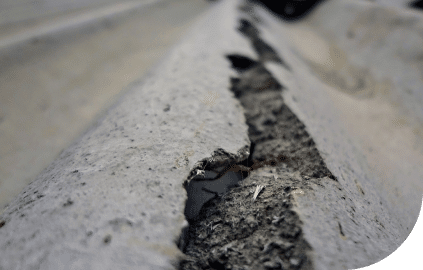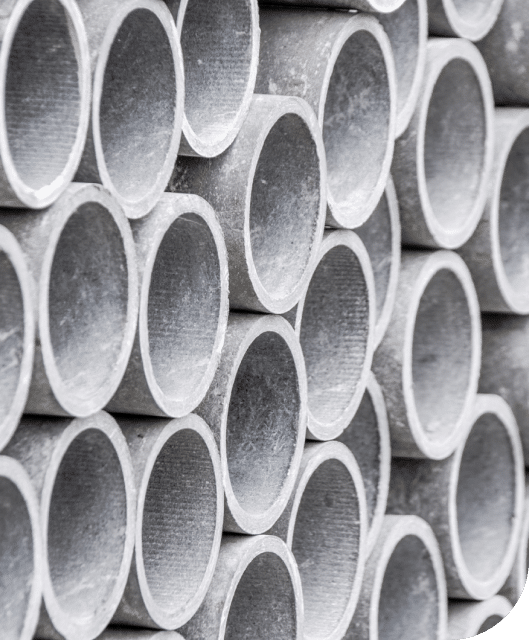Asbestos Cement
Construction crews, manufacturing employees, and consumers who come in contact with asbestos-laden cement are at increased risk for developing serious health conditions, including mesothelioma and other cancers. These individuals and their families may be entitled to compensation due to the asbestos exposure. If you or a family member have been diagnosed with an asbestos-related illness after handling cement containing asbestos, the team at Lanier Law Firm can help you with your case.
Home » National Mesothelioma Law Firm » Asbestos Exposure » Asbestos in Consumer Products and Materials » Asbestos in Cement
Whether you worked on a construction site 30 years ago or currently reside in, work in, remodel, or help demolish old buildings, chances are you were exposed to, asbestos Touted as the solution to making building materials lighter in weight while also increasing their strength, asbestos was easy to find, fire resistant, and inexpensive to manufacture. Asbestos was used in everything from asbestos cement to pipes and drainage products for over six decades.
If you or a family member have been diagnosed with mesothelioma or other respiratory or gastrointestinal cancers, you may have been unknowingly exposed to cement containing asbestos decades ago. The damaging effects of asbestos exposure may not show up for years, and the results can be emotionally and financially devastating. Don’t let asbestos-related medical bills, lost wages, lost future earnings, and pain and suffering jeopardize your family’s future security.
The asbestos attorneys at The Lanier Law Firm haves decades of experience to fight for the fair compensation you deserve. We can help you pinpoint the time and location of your asbestos exposure and file a claim to hold the responsible parties accountable. With offices in Houston, New York, and Los Angeles, The Lanier Law Firm seeks justice for clients dealing with asbestos exposure.
When was asbestos used in cement?
The practice of using asbestos in cement and cement products in the United States began in the early 20th century and continued until the U.S. Environmental Protection Agency banned its use during the 1980s.
Even though the United States banned asbestos for most uses, cement products containing less than 1 percent asbestos can still legally be imported from other countries.

Why is asbestos cement dangerous?
In a wet or settled form, asbestos is fairly harmless to humans. During the manufacturing, installation, or demolition of asbestos cement products, asbestos breaks apart or is disturbed and releases dust. Microscopic fibrous particles are stirred up in the air and inhaled or ingested. These fibers become embedded in the lining of the lungs, stomach, and other organs. Over time, scarring can lead to asbestosis, mesothelioma, and other cancers of the respiratory and gastrointestinal systems.
Particles in asbestos cement are so small, it’s impossible to see when asbestos is present with the naked eye. Fibers can remain airborne for extended periods, leaving anyone who comes in contact with them at higher risk for developing cancer. Most victims aren’t diagnosed until years after asbestos exposure. Since mesothelioma is difficult to diagnose, many patients don’t find out until it’s too late to seek treatment.
How was asbestos cement used in construction?
Products containing asbestos cement were also called transite, plastic cement, AC board, finishing cement, AC pipe, bonding cement, refractory cement, AC sheets, and corrugated sheets. Asbestos was used in the following products:
- masonry mortar used between bricks and stonework
- joint compound
- concrete foundations and support pillars
- asbestos cement shingles
- ceilings
- flooring
- pressure pipes and drainage products
- gutters and downspouts
- fire control bricks for chimneys, flues, and fireplace heat shields
- insulation
- furnaces and furnace duct work
- asbestos cement siding
Cement sheeting was also frequently used to construct military barracks and to line the interior walls of naval vessels, boiler rooms, and engine compartments on ships.
Which occupations are most affected by
asbestos cement?
There is no safe amount of asbestos exposure, but the duration of time and the amount of asbestos present do play a part in how likely you are to develop complications later. When an individual works with materials containing asbestos daily, occupational exposure puts them at a much higher risk than someone who simply came into contact when they walked by a construction site. Employees in the construction and manufacturing industries are most likely to suffer illnesses related to asbestos cement exposure, including:
- cement manufacturing plant employees
- industrial workers
- bricklayers and stone masons
- foundation pourers
- construction crews
- building inspectors
- siding, roofing, and flooring installers
- plumbers, pipefitters, and boilermakers
- ship crews, shipyard, and dock workers
- military personnel who were exposed to debris from bombed-out buildings
Developing health complications from secondary exposure to asbestos cement dust is also possible. In a 2001 case in Baltimore City, the court awarded the daughter of a pipe fitter damages after she developed mesothelioma from washing her father’s dust-covered clothing.
What companies manufactured asbestos cement products?
Records and internal documents revealed that companies knew about the dangers of asbestos and continued to use it anyway. They deliberately ignored the signs and placed their employees and consumers in harm’s way. They didn’t protect their workers by supplying masks and other protective gear that might have prevented them from inhaling or ingesting asbestos fibers.
Some of the companies known for manufacturing asbestos cement include:
- Johns-Manville
- Celotex Corporation
- GAF Corporation
- CertainTeed
- National Gypsum
- Armstrong World Industries
- Keasbey & Mattison

What is an asbestos cement trust fund?
Many companies that faced asbestos lawsuits were forced to file for Chapter 11 bankruptcy. As a result, the courts ordered them to establish trust funds to compensate victims who later developed mesothelioma and other exposure-related illnesses. These funds were set aside for future claims to help victims and their families cover medical expenses, lost wages, and pain and suffering. Asbestos trust funds hold an estimated $30 billion today.
If you or a family member was exposed to asbestos cement and have since been diagnosed with mesothelioma or other associated conditions, you may be entitled to compensation for your injuries. Established asbestos trusts can be a faster way to receive compensation since filing a lawsuit is unnecessary. Asbestos cement trusts already in place include:
- Kaiser Asbestos Trust
- Johns-Manville Corp Bankruptcy Trust
- Armstrong World Industries Asbestos Trust
Do I need an attorney for my asbestos cement case?
You will need an asbestos attorney experienced in handling asbestos exposure claims to help you navigate the process, regardless of whether you are eligible to receive compensation from an established trust. Even if you don’t qualify for a trust settlement, you may still be able to file a lawsuit to recover damages.
Lanier Law Firm has a proven track record of securing large settlements in asbestos and mesothelioma cases:
- $115 million settlement on behalf of steelworkers afflicted with asbestos-related illnesses
- Verdict in favor of a retired pipe fitter diagnosed with mesothelioma after using products containing asbestos that were manufactured by John Crane Inc.
- $4.65 billion settlement from Johnson & Johnson for its role in exposing consumers to talcum powder containing asbestos
An asbestos settlement or judgment in your favor can’t restore your physical health, but it can provide you and your family with the financial security you need so you can focus on living. Learn more from our asbestos and mesothelioma attorneys at the Lanier Law Firm about how to move forward with an asbestos exposure case today.
By submitting this form, you agree to our terms & conditions. Please read the full disclaimer



